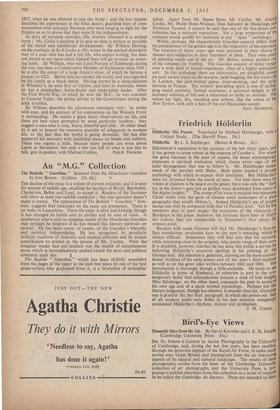Bird's-Eye Views
Monastic Sites from the Air. By David Knowles and J. K. St. Joseph, (Cambridge University Press. 55s.) DR. ST. JOSEPH is Curator in Aerial Photography in the UniversitY of Cambridge, and, during the last five years, has been enabled, through the generous support of the Royal Air Force, VS make mallY sorties over Great Britain and photograph from the air interesting aspects of its natural and cultural landscape. The results of thes° photographic sorties form the basis of the Cambridge UniversirY collection of air photographs, and the University Press is pro' posing to publish selections from this collection in a series of volumes to be called the Cambridge Air Surveys. These are intended to illus' trate the uses of air-photography in various fields of archaeology, social history, human and physical geography, ecology and other subjects: they are being edited by Professor Knowles, Dr. St. Joseph and Dr. Godwin.
This present volume is the first of the series; it consists of 130 of Dr. St. Joseph's photographs of mediaeval religious houses. In addition it has a valuable introductory essay, and a historical and descriptive text to accompany each photograph, both written by Professor Knowles. The photographs selected are not confined to the beautiful and large monasteries but attempt to give as wide and representative a survey as possible. The whole is a notable contribution to our descriptive literature of monastic sites and to our documentation of air-photographs. It would have been nice to have plans of all the sites illustrated, where plans are available. The plan is not always obvious in the photographs, which are all oblique views taken from heights between 800 and 2,000 feet. In general their quality is very good, but several of them are woolly and lack sharp definition. Oblique photographs must always be a second-best substitute for the stereoscopic examination of verticals where detailed interpretation of aerial views is required. This is not so important in the present volume, which launches a series and which, at its high price, must try to have an immediate popular appeal. Its subject is well suited to illustration by obliques, but verticals would have brought out much better many of the details of plan to which Professor Knowles draws attention. Subjects treated in later volumes in the series will demand stereoscopic treatment. Good vertical cover already exists at a scale of one in ten thousand of most of Britain. The spread of stereoscopic films and eventually stereoscopic television will soon make us all insistent on three-dimensional book illustration. A combination of stereo- gram and oblique is probably the ideal way of illustrating Britain from the air in books. It will not be beyond the ingenuity of the editors of this series and of the Cambridge University Press to devise this ideal combination in illustrating future Cambridge Air Surveys.
GLYN E. DANIEL.



















































 Previous page
Previous page